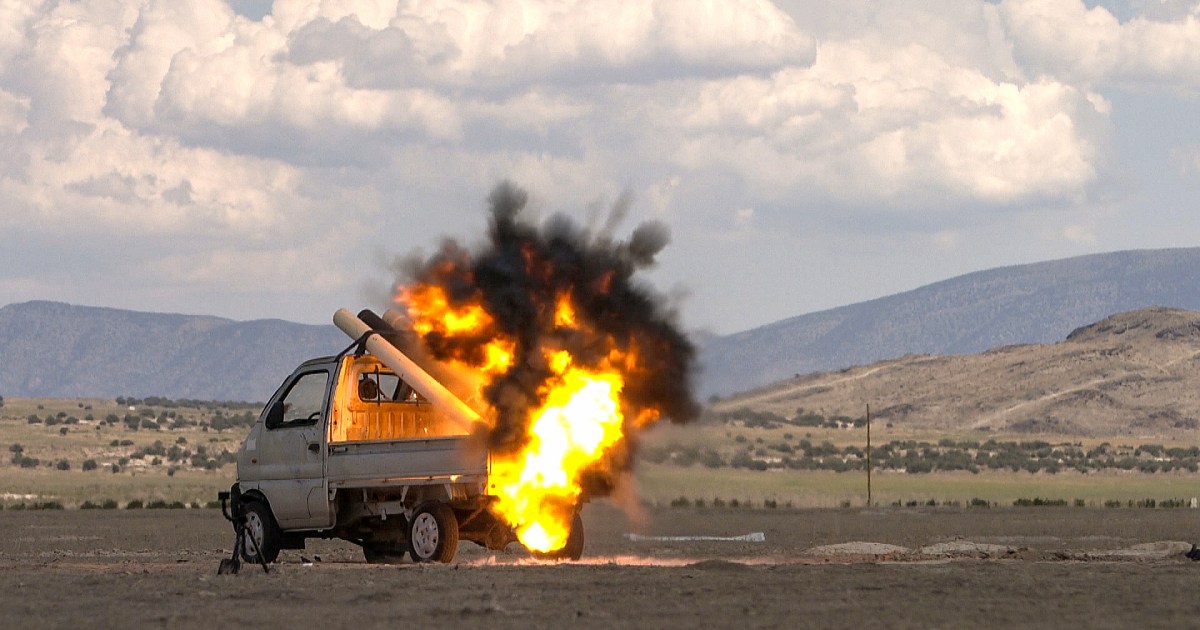
Kamikaze drones: A new weapon brings power and peril to the U.S. military
Some experts believe the spread of low-cost, light-weight "killer" drones will change ground warfare as profoundly as the machine gun did.
Kamikaze drones: A new weapon brings power and peril to the U.S. military
Some experts believe the spread of low-cost, light-weight "killer" drones will change ground warfare as profoundly as the machine gun did.
Dec. 6, 2021, 4:01 PM EST
By Ken Dilanian
DUGWAY PROVING GROUND, Utah—The killer drone whooshed out of its launch tube, spreading its carbon wings and shooting into the sky.
Flying too fast for the naked eye to track, the battery-powered robot circled the Utah desert, hunting for the target it had been programmed to strike. Moments later, the drone sailed through the driver’s side window of an empty pick-up truck and exploded in a fireball.
“Good hit,” exclaimed an operator from AeroVironment, the company that produces the drone and sells it to the U.S. military.
NBC News traveled to a military testing center for exclusive access to the first-ever public demonstration of the Switchblade 300, a small, low-cost “kamikaze” drone made by AeroVironment that sources say has been used quietly for years by the U.S. military in targeted killing operations in Afghanistan, Iraq and Syria.
The demonstration told a story of promise and peril.
Americans have become accustomed to images of Hellfire missiles raining down from Predator and Reaper drones to hit terrorist targets in Pakistan or Yemen. But that was yesterday’s drone war.
A revolution in unmanned aerial vehicles is unfolding, and the United States has lost its monopoly on the technology.
Some experts believe the spread of these semi-autonomous weapons will change ground warfare as profoundly as the machine gun did.
They can leapfrog traditional defenses to strike infantry troops anywhere on the battlefield, and they cost just $6,000 apiece compared to $150,000 for the Hellfire missile typically fired by Predator or Reaper drones. That capability could help save the lives of American troops, but it could also put them — and Americans at home — in great danger from terrorists or nation states that haven’t previously had access to such lethal and affordable technology.
“I think this is going to be the new IED,” said Shaan Shaikh, a missile expert at the Center for Strategic and International Studies. “It’s something that we can see that is going to be a problem, and we have some defenses, but not enough.”
Dubbed kamikaze, suicide or killer drones, these unmanned aircraft don’t fire missiles — they are the missiles. But unlike typical missiles, they can circle above a target, wait for the ideal moment, and strike with incredible precision.
The U.S. military could not have fought the way it did in Iraq or Afghanistan if the enemy had killer drones. America’s next battlefield opponent is likely to have them. And terrorists will eventually get them, too — a possibility that has homeland security officials scrambling to find a solution, given that there is no surefire defense against them.
“There are over 100 countries and non-state groups that have drones today, and the technology is widely proliferating,” said Paul Scharre, a former Army Ranger, scholar at the Center for a New American Security and author of “Army of None,” a book about autonomous weapons. “It levels the playing field between the U.S. and terrorist groups or rebel groups, in a way that's certainly not good for the United States.”
Today’s small lethal drones are difficult to detect on radar and can even be programmed to hit a target without human intervention, based on facial recognition or some other computer wizardry. And, while billions of dollars are being spent at the Pentagon and the Department of Homeland Security to come up with “counter drone” technology, experts say there is, as yet, no foolproof version of it.
Weighing just five and a half pounds including its small warhead, the Switchblade can be brought into battle in a backpack and can fly up to seven miles to hit a target. The 300 model is designed to kill individuals, while a larger version, the 600, can destroy armored vehicles. AeroVironment is not yet allowed to show the bigger one to the public.
They are called “Switchblade” because their blade-like wings spring out on launch.
“It allows our warfighter to have a battlefield superiority, which our enemies can't see, can't hear, can't tell it's coming, and really precisely achieve a specific mission effect,” said Wahid Nawabi, AeroVironment’s Afghan-born CEO.
Nawabi said he’s been told the Taliban and others who have been on the receiving end refer to it as an angry bird or a buzzing bee.
Public procurement data shows that the Switchblade 300 costs a fraction of each Hellfire missile’s price tag, let alone the total cost of keeping Reaper drones in the air, flown by pilots in Nevada.
The Switchblade has a feature that allows the operator to adjust the blast radius, so that it can kill the driver of a vehicle but not the passenger, for example. The weapon can be “waved off,” up to two seconds before impact, AeroVironment says, in the event of a mistake or risk to civilians.
That wave-off capability is notable in light of the catastrophe in September, when the military killed ten civilians, including seven children, in an Afghanistan drone strike in what officials now call a tragic mistake. A Pentagon review found that the strike team was unaware of the presence of children when it decided to fire. Officials told NBC News that a child was observed through a video feed of the target area after the launch, but by then the Hellfire missile could not be recalled.
Pentagon admits 10 civilians were killed in drone strike on Afghanistan
The Switchblade has cameras attached that show the target seconds before impact. But for a better view of the battlefield it’s often used in conjunction with a small surveillance drone.
For the NBC News demonstration, AeroVironment used the Puma, which is launched by hand like a large model airplane, and provides high resolution, color imagery of the ground. The images beamed back from the Puma’s cameras made clear that an operator could the expression on the face of his target in the seconds before the Switchblade struck.
Portable drones provide air support to small ground force units even when overhead assets — fighter jets, helicopters, larger drones — aren’t available, Scharre said.
“The ability to have something that's small and tube-launched that's in your backpack that the squad leader has access to that they don't have to get on the radio and call in close air support … that is a real game changer from a military capability standpoint,” he said.
But it’s not just a game-changer for the United States.
The Switchblade may be the most advanced of the genre, but Russia, China, Israel, Iran and Turkey all have some version of a killer drone. Iranian-backed militias have used small drones in ten attacks so far this year on American bases in Iraq, the military says. No U.S. personnel have been hurt or killed, but this is only the beginning.
The tiny nation of Azerbaijan used small Turkish-made drones to devastating effect against the Armenian military last year, bringing a decisive end to a stalemate over a disputed enclave that had gone on for years.
Video released by Azerbaijan shows the drones pummeling artillery, tank and troop emplacements surrounded by trenches that offered no protection whatsoever from the fiery death raining down from above.
Russia and Ukraine have used armed drones in fighting over a disputed region, and Iranian-backed Houthi rebels used them to blow up Saudi oil facilities in 2019.
Drones, Scharre and other experts say, may usher in the largest transformation of ground war tactics since the advent of the machine gun at the turn of the 20th century, which quickly put an end to the practice of large formations of troops marching into gunfire.
Drones “are making the battlefield a much more dangerous place for ground troops,” Scharre said. “Now, hiding behind a wall, hiding in a trench line is not enough to protect you from the enemy.”
U.S. troops in Iraq are now experiencing that danger firsthand. Iranian-backed militias have used small drones in nine separate attacks on American facilities in Iraq this year, a U.S. military spokesman told NBC News. No one has been hurt or killed, but it’s only a matter of time.
A suicide drone attack on an oil tanker linked to an Israeli billionaire killed two crew members off Oman in the Arabian Sea on July 29.
“We have found that every time we come up with some way to defend ourselves against (drones), the technology rapidly advances to the point where it defeats our defensive capabilities,” said Michael Patrick "Mick" Mulroy, a retired Marine and former CIA officer who served as Deputy Assistant Secretary of Defense for the Middle East from 2017 to 2019.
Mulroy, an ABC News analyst, said that drone defenses include electronic jamming and various methods to shoot them down, but there are technologies and tactics to bypass every possible defense.
The military, for example, can sometimes shoot high-powered weapons at incoming drones on a battlefield.
Inside populated areas, however, small, explosives-laden unmanned aerial vehicles pose a more vexing problem.
In a war zone, “you could do more things with electronic warfare…with using high powered microwaves that might be very disruptive in a domestic context,” Scharre said. “You could shoot bullets on the sky in a war zone, and you might be less concerned about where they're going land out in the desert than in a major American city.”
Meanwhile, all the barriers put up in cities to keep truck bombs away from buildings are useless against drones.
So far, no terror group is known to have used a suicide drone. But experts believe it’s only a matter of time. ISIS put explosives on hobbyist drones and used them to harass and occasionally injure coalition forces in Iraq and Syria.
The specter of a swarm of explosives-packed drones buzzing toward a crowded American sports arena keeps homeland security officials up at night.
But the U.S. government has been slow to react. It was only in 2018 that Congress granted the Department of Homeland Security and other law enforcement agencies the authority to take down a drone deemed a threat inside the United States.
Since then, DHS has been contracting with outside firms and testing technologies in an effort to defeat the drone threat.
NBC News asked DHS’s Science and Technology Directorate for an update on the state of domestic counter drone programs, but a spokesman declined to comment.
In a July article on DHS’s web site, the agency discusses some of its counter drone efforts, and notes that tests have been conducted. But the article does not say whether the tests showed that any of the technology works consistently.
In 2018, the then head of DHS’s intelligence division told Congress that drones posed a major threat.
“Commercially available drones can be employed by terrorists and criminals to deliver explosives or harmful substances, conduct surveillance both domestically and internationally against U.S. citizens, interests and assets,” said David Glawe, then a DHS official. “This threat is significant and it's imminent and it's upon us.”
What do you think the 'life expectancy' of the White House is? I'd say it just took a significant drop.






 didn't think so... drat.
didn't think so... drat.